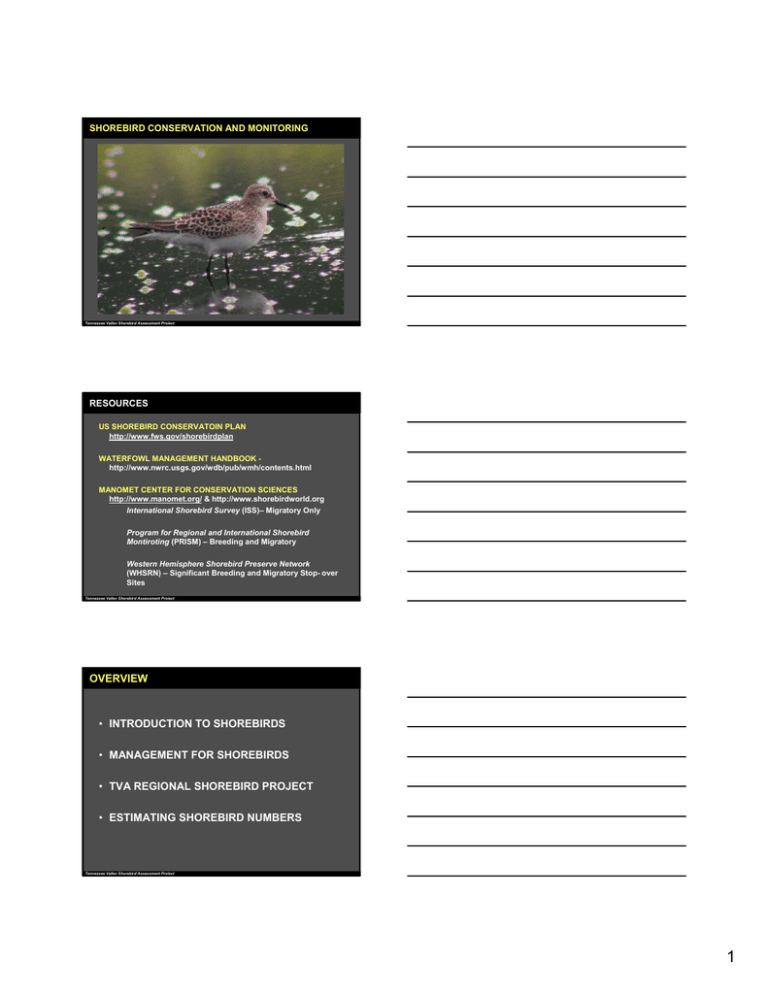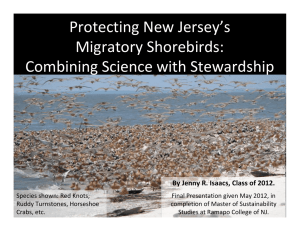Wood duck Management - Forestry, Wildlife and Fisheries
advertisement

SHOREBIRD CONSERVATION AND MONITORING Tennessee Valley Shorebird Assessment Project RESOURCES US SHOREBIRD CONSERVATOIN PLAN http://www.fws.gov/shorebirdplan WATERFOWL MANAGEMENT HANDBOOK http://www.nwrc.usgs.gov/wdb/pub/wmh/contents.html MANOMET CENTER FOR CONSERVATION SCIENCES http://www.manomet.org/ & http://www.shorebirdworld.org International Shorebird Survey (ISS)– Migratory Only Program for Regional and International Shorebird Montiroting (PRISM) – Breeding and Migratory Western Hemisphere Shorebird Preserve Network (WHSRN) – Significant Breeding and Migratory Stop- over Sites Tennessee Valley Shorebird Assessment Project OVERVIEW • INTRODUCTION TO SHOREBIRDS • MANAGEMENT FOR SHOREBIRDS • TVA REGIONAL SHOREBIRD PROJECT • ESTIMATING SHOREBIRD NUMBERS Tennessee Valley Shorebird Assessment Project 1 WHAT ARE SHOREBIRDS? • • • • • • Sandpipers Dowitchers Plovers Oystercatchers Avocets Stilts 214 SPECIES WORLDWIDE 50 REGULARLY OCCUR IN U.S. 31 OCCUR IN TN RIVER VALLEY Painting by James Coe Tennessee Valley Shorebird Assessment Project MIGRATORY SPECIES RED KNOT 20,000 MILES IN 1 YEAR BAR-TAILED GODWIT 6,000 MILES NON-STOP Tennessee Valley Shorebird Assessment Project NICHE PARTITIONING AMERICAN GOLDEN PLOVER AVOCET VARING BILL SHAPES AND LENGTHS ALLOW MULTIPLE SPECIES TO FORAGE IN SAME AREA Tennessee Valley Shorebird Assessment Project 2 EXAMPLES OF SHOREBIRDS IN TN RIVER VALLEY KILLDEER GLEANS PREY FROM MUD TO UPLAND ZONES Tennessee Valley Shorebird Assessment Project BLACK-BELLIED PLOVER SIMILAR FORAGING STRATEGY AS KILLDEER Tennessee Valley Shorebird Assessment Project PECTORAL SANDPIPER FORAGES WITHIN VEGETATION AND MUD ZONE INCLUDING VERY SHALLOW WATER Tennessee Valley Shorebird Assessment Project 3 GREATER YELLOWLEGS PRIMARILY FORAGES IN WATER Tennessee Valley Shorebird Assessment Project SNIPE SHALLOW WATER AND MUD ZONE, OFTEN AROUND VEGETATION Tennessee Valley Shorebird Assessment Project DUNLIN SHORT-BILLED DOWITCHER WADES IN DEEPER WATER, NOTE LONG BILL Tennessee Valley Shorebird Assessment Project 4 MANAGEMENT OF SHOREBIRD HABITAT-BREEDING PROMOTE NATIVE GRASSLANDS – SHOREBIRDS PREFER TO NEST IN GRASSLAND HABITATS. USE OF THESE HABITATS VARIES BY SPECIES, SOME (AVOCETS) PREFER SPARSELY VEGETATED HABITATS. OTHER SPECIES (UPLAND SANDPIPER) PREFER GRASSLANDS WITH MORE VERTICAL STRUCTURE. PRESCRIBED BURNING - A USEFUL TOOL FOR DEVELOPING SHOREBIRD NESTING HABITAT. ESTABLISH BREEDING SITES NEAR FOOD SOURCE – NECESSARY FOR MOST SPECIES, ALTHOUGH NOT NEEDED FOR PLOVERS, AS THEY ACTIVELY FEED IN VEGETATIVE ZONE. RED KNOT Tennessee Valley Shorebird Assessment Project MANAGEMENT FOR SHOREBIRDS - MIGRATION MOIST MUD FLAT HABITAT WITH <20% VEGETATIVE COVER SHALLOW WATER <20 CM DEEP LARGER FLATS ARE BETTER – REDUCES IMPACTS FROM DISTURBANCES. TIMING IS CRITICAL - HABITAT MUST BE AVAILABLE WHEN BIRDS ARE PASSING THROUGH. MIGRATORY PERIOD BEGINS MID-JULY-OCTOBER, ADULTS MOVE THROUGH AREA BEFORE JUVENILES. ALSO PROVIDE HABITAT FOR WINTERING SPECIES (DUNLIN, LEAST SANDPIPERS). MANAGED SUB-IMPOUNDMENTS – SHOULD BE DRY IN SUMMER, DISK VEGETATION, FILL AND SLOWLY DRAIN. EXOTIC VEGETATION CAN BE PROBLEMATIC. Tennessee Valley Shorebird Assessment Project HOW DID TVA GET INVOLVED WITH SHOREBIRDS? TVA’S RIVER OPERATION STUDY Tennessee Valley Shorebird Assessment Project 5 Regional Assessment and Management of Inland Stopover Habitats for Shorebirds in the Tennessee Valley Tennessee Valley Shorebird Assessment Project Partnerships Tennessee Valley Authority Tennessee Wildlife Resources Agency U.S. Fish and Wildlife Service Kentucky Department of Fish and Wildlife Resources Alabama Department of Conservation and Natural Resources University of Tennessee, Knoxville US Army Corps of Engineers Tennessee Valley Shorebird Assessment Project Overview Construction of TVA dams over the past 60+ years has created extensive inland mudflat habitats in the Tennessee river valley through fall drawdown of the reservoir system There have been several major changes in the way TVA manages fall drawdown: •1970’s, 1980’s saw major changes system wide •Other, smaller-scale changes on individual reservoirs •Latest change: Reservoir Operations Study (ROS), an extensive study of environmental impacts caused by different reservoir management scenarios •One area of special concern in the ROS was the impact of extended summer reservoir levels, delaying the creation of mudflat habitats used by migrating shorebirds. There has never been a valley-wide, systematic study of shorebird habitat use. No evidence that any of the past reservoir management scenarios has been optimal for creating shorebird habitat. Tennessee Valley Shorebird Assessment Project 6 Project Goals As part of the ROS record of decision, TVA will fund a 5 year study of shorebird resources across the Tennessee River Valley. Primary objectives of the study: •What shorebird species migrate through the valley, and in what numbers? •When do they migrate through? Look at individual species and total number of individuals in all species. •Where do shorebirds stopover in the valley? Do mudflats on TVA managed reservoirs play a key role in long-term migration stability? •How does TVA management of the river system affect stopover habitats? Can we identify an ideal river management scenario that provides the best combination of timing and extent of habitat availability? Key point: Although we are tasked with assessing management impacts of ROS, the scientists involved in the study are most interested in an overall assessment of shorebird resources both on and off TVA lands, in cooperation with other state and federal agencies and public interest groups. Tennessee Valley Shorebird Assessment Project Tennessee River Valley •TVA manages 9 mainstem reservoirs and 40 tributary reservoirs. •Multiple use management system. •Tributary reservoirs provide little habitat due to local geomorphology—steep sided, deep lakes with few mudflats. •Mainstem reservoirs are shallow and provide a lot of habitat. Of these Kentucky and Wheeler reservoirs encompass the most. Douglas and Chickamauga provide key habitat in the eastern valley. Tennessee Valley Shorebird Assessment Project Reservoir Operations Study Five year study to examine all aspects of TVA’s management of the Tennessee River System. ROS results guide daily management of the river system. •Multiple use: Navigation, flood control, power production, recreation, resource conservation. •Key public concern was to keep docks and marinas open through Labor Day. Extension of summer pool was accepted on some reservoirs, rejected on others. •No change on Kentucky lake, which has a majority of valley shorebird habitat. Changes in the 1990s were evaluated by TVA and other agencies, and determined harmful to habitat and flood control. •River Operations Group continues to evaluate ROS. Our study will provide valuable information on shorebird habitats and timing, and help make better decisions. ROS is an adaptive management plan. Tennessee Valley Shorebird Assessment Project 7 Changes in reservoir levels under ROS Kentucky Lake Mudflats Start Lots of Mudflats Wheeler Lake Tennessee Valley Shorebird Assessment Project Changes in reservoir levels under ROS Chickamauga Lake Douglas Lake Tennessee Valley Shorebird Assessment Project Regional habitat assessment •Collaborative effort, with TVA helping to organize surveys identify areas to monitor. •May 2005: first regional meeting with TVA, TWRA, USFWS, KYFWS and other interested parties to begin organizing this valley-wide effort. Other, regional meetings to follow. Includes identification workshops, protocol review, identification of habitats. International Shorebird Survey protocol: •Survey sites each third of the month starting in July and ending in October •Conduct surveys throughout the valley on the same day as weather and logistics permit •Alternative guidelines for less intensively monitored sites. Monitoring by agencies on key sites, citizen scientists on other sites •Periodic monitoring to gauge overwintering possibilities. Tennessee Valley Shorebird Assessment Project 8 Techniques to identify and assess key habitats •Expert opinion captured as valley-wide map series, identifying both on and off reservoir habitats •Historic maps showing pre-impoundment elevations to highlight locations where unknown mudflats may exist •Cooperative work with Corps of Engineers for bathymetry and aerial photography •LIDAR and aerial photography on key flats to quantify mudflat availability at different reservoir levels •Vegetation study to quantify habitat suitability for overwintering waterfowl Tennessee Valley Shorebird Assessment Project Habitat Mapping Tennessee Valley Shorebird Assessment Project Habitat Mapping Tennessee Valley Shorebird Assessment Project 9 How much habitat •A critical question is how much exposed mudflat is required to support the number of birds migrating through at any given time •Trying to identify the best scenario to provide ideal habitat to the highest number of birds and species: When is habitat exposed, and how much is exposed at any given elevation? Is this best for birds? Tennessee Valley Shorebird Assessment Project LIght Detection and Ranging (LIDAR) • Laser Data Acquisition Technology • Airborne system for rapid coverage of difficult terrain and applications • Laser points are positioned by highly accurate GPS and Inertial Measurement System • Produce very precise digital elevation models (DEMs) •Acquires 15,000 points per second , 1 point every square meter on the ground •Typical vertical accuracy + 4-6 inches •Typical horizontal accuracy + 12-30 inches Tennessee Valley Shorebird Assessment Project Systematic Shorebird Surveys Tennessee Valley Shorebird Assessment Project 10 Reservoir Level 990 Tennessee Valley Shorebird Assessment Project Reservoir Level 987 Tennessee Valley Shorebird Assessment Project Reservoir Level 985 Tennessee Valley Shorebird Assessment Project 11 Reservoir Level 983 Tennessee Valley Shorebird Assessment Project Reservoir Level 980 Tennessee Valley Shorebird Assessment Project Reservoir Level 975 Tennessee Valley Shorebird Assessment Project 12 Reservoir Level 970 Tennessee Valley Shorebird Assessment Project Historic Patterns & Citizen scientists August (n=2465 birds, 19 visits) Semipalmat ed Solit ary Spot t ed Sandpiper Sandpiper 3.4% 2.0% Dunlin 0.0% Great er Yellowlegs 2.3% Plover 1.5% Killdeer 27.1% Septem ber Solitary (n=1552 birds, 14 visits) Spotted Sandpiper Greater Sandpiper 0.2% Yellow legs 1.1% Semipalmat 0.5% ed Plover 6.7% Killdeer 34.2% Peeps 33.7% Peeps 38.1% October Solitary (n=544 birds, 9 visits) Sandpiper Spotted 0.2% Sandpiper 0.4% Peeps Pectoral 11.2% Sandpiper 7.5% Other 0.4% Lesser Yellow legs 1.5% Dunlin 43.4% Lesser Yellowlegs 7.0% Ot her Pectoral Sandpiper 11.1% 2.8% Pect oral Sandpiper Novem ber (n=1756 birds, 7 visits) Pect or al Sandpiper Lesser Yellowlegs 0.6% Ot her 0.5% Other 5.2% Lesser Yellow legs 3.0% Killdeer 34.6% Greater Yellow legs 0.9% Decem ber (n=166 birds, 2 visits) Peeps Peeps 22.3% 3.0% Solit ar y Sandpiper 0.2% 0.1% Killdeer 12.9% Pectoral Sandpiper 0.6% Gr eat er Yellowlegs 1.8% Dunlin Killdeer 77.1% 81.0% Tennessee Valley Shorebird Assessment Project Migration Timing Tennessee Valley Shorebird Assessment Project 13 Migration Timing Tennessee Valley Shorebird Assessment Project University studies TVA is funding university studies on specific habitat questions: •University of Tennessee, Department of Geography: role of mudflat shape and reservoir level in creating mudflat habitats during fall migration. •University of Tennessee, Department of Forestry, Wildlife and Fisheries: waterbird use of mudflats in east Tennessee. Examining vegetation development, abundance of invertebrates, and seasonal use of flats by shorebirds and waterfowl. Other studies as funding and needs warrant: •Similar waterbird study in west TN. Tennessee Valley Shorebird Assessment Project What have we learned? 1. Historical shorebird data does not adequately depict presence of species throughout fall migration. We need data to be acquired systematically, throughout migratory period. 2. Approximately 150 mud flats exist throughout the Valley, only a fraction provide optimal habitat for shorebirds. 3. Delaying drawdown results in an overall reduction in vegetative biomass and species diversity. 4. Reservoir drawdown should be slow and steady, dramatic drawdowns result in poorly developed vegetative communities; limiting the establishment of moist soil species. Tennessee Valley Shorebird Assessment Project 14 Questions? Contact information: Roger Tankersley, Jr.: GIS and habitat assessment <rdtankersley@tva.gov> Travis H. (Hill) Henry: Shorebird monitoring <thhenry@tva.gov> Michael Roedel: Tennessee Wildlife Resources Agency <Michael.Roedel@state.tn.us> Tennessee Valley Shorebird Assessment Project APPLICATION OF DRAWDOWN MODEL A MODEL TO DETERMINE SHOREBIRD HABITAT AVAILABILITY UNDER DIFFERENT DRAWDOWN REGIMES. Tennessee Valley Shorebird Assessment Project 15

